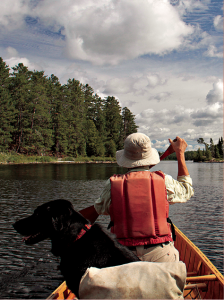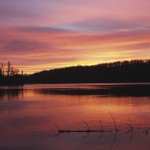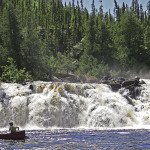There is mystery surrounding Quetico Provincial Park; that northern half of the beloved canoe country. To many people, it signifies an ideal; what they wish the Boundary Waters could be. For these people, the Quetico is a place of solitude, of exploration, of magic.
Others are intimidated by the Quetico. They see it as possibly too remote, a place where they fear they will be tested beyond their abilities. They’ve heard stories of difficult routes or portages that are hard to find.

In reality, the Quetico is probably both. It does indeed offer more solitude than the Boundary Waters. There are more “off the beaten track” routes. And yes, sometimes on these routes, portages can be difficult to find and traverse. But anyone who has polished their abilities on a few BWCAW trips would have the skills needed to visit the Quetico. What defines the Quetico is not any dramatic physical difference, but instead is the result of management choices and fortunate geography.
Both areas are the epitome of canoe country. The majority of portages are short and the lakes seemingly numberless. Both share the beauty of the Canadian Shield, the sweeping granite underpinnings of that part of the world. Though some of the flora in the south central part of the Boundary Waters is more deciduous, much of the habitat and topography of the Boundary Waters and Quetico is very similar. Aside from the Forest Service firegrates, most BWCAW campsites could be easily mistaken for a site in the Quetico.
The biggest difference between the two is the level of solitude, plain and simple.
That greater sense of solitude is the result of Quetico’s physical shape and the park’s management strategies. Unlike the Boundary Waters, which is long (east to west) and narrow (north to south), Quetico is about as wide as it is long. Though both contain nearly the same acreage—about one million acres—how that acreage is accessed plays considerable impact on its use.
Quetico is buffered on the south by the Boundary Waters, and has no roads leading to either the west or east sides, unlike the BWCAW, which is bisected by two major roads, allowing access to it along its length. While access to the Quetico is good from the north, most Canadians choose to recreate elsewhere (over 80 percent of Quetico visitors are Americans). The necessity of applying for a Remote Areas Border Crossing Permit from Canada Customs so that one can legally enter from the U.S. is a step some are unwilling to take. Thus, simply getting into the Quetico is more difficult, which strips away almost all day use, and a significant number of overnight visitors.
Yet, even if access were easier, the park’s management would preserve a great deal of that solitude. On average, Quetico allows about one-quarter the number of permits than the Forest Service allocates for the Boundary Waters. In recent years, because the user fees to visitors of the Quetico have risen to be significantly higher per person than in the BWCAW, affordability has become an issue for some. There are times now when Quetico permits go unused, further reducing visitor numbers.

The end result is that once one does enter the Quetico, you can expect to see few people, even during August, the peak month. Two years ago in mid-August, Mary Jo and I entered from the U.S., took two portages into the park, and camped on a glorious point of rock for four nights. Except for entering, we saw no other people. We moved on to yet another lake the next day, seeing no one while we paddled, and no one for the following three days at the next camp. It wasn’t until we returned to the busy border route that we began to encounter other paddlers.
Besides solitude, Quetico offers a nearly endless choice of routes, some obvious, some obscure. If you’re the kind of wilderness enthusiast that wants to cover a lot of territory, wants to explore places that few others have seen, this is the place to go. Just last year, Mary Jo and I took a route that was more traveled by moose than by humans, and where only a very experienced eye could discern where the portages were. The fact that those kinds of places still exist is a balm for our souls.
None of this should be construed as a slap in the face to the Boundary Waters, which is just as beautiful, and which I love just as much. They complement each other.
However, if what you want is an extended trip through more remote country, one with the chance for true solitude, I think you hear the Quetico calling.




